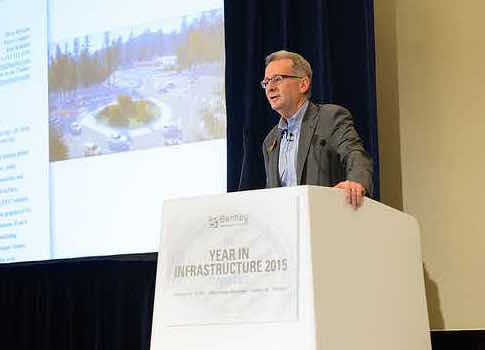Bentley Systems panel touts value to extending design information to operations at Year In Infrastructure event in London.

What happens to plant equipment data after it is captured in the design and build stages? Panelists at an industry forum in London on Nov. 4 at Bentley Systems’ annual Year In Infrastructure event said the data largely gets shelved, and unless that practice changes, it will keep the Industrial Internet of Things (IIoT) from reaching its full potential.
"We’re very much in need of revolution," said Ed Merrow, CEO of Virginia-based Independent Project Analysis (IPA). "In the industrial world, we need to get industry to use (design data) in operation. Then it will take on a life of its own. In the industrial world, most owners never take physical possession of the database that underlies their operation."
Today, 3D modeling is a common practice, and virtual-reality is a more standard tool to show how a building exists in its environment. As a result, design and construction software can tag every piece of equipment installed in greenfield facilities. Migrating that information for continued use by operations seldom occurs, and that is a huge waste of capital and information, Merrow told about 1,000 building, design and infrastructure professionals from around the world.
"We build assets that will last a generation, if not longer," he said. "The money is in the operations of these assets. We’ve got to show the decision-makers that it works. Because it’s the next quarter’s earning that they are interested in, we’ll have to change the immediacy. Where we’ve been moving into asset optimization makes sense."
Since the 3D design model has all of the relevant information about the equipment, it can be easily migrated into a functioning 3D operations model. While the technology exist, Merrow noted, the adoption lags far behind, and its costs manufacturers money.
"Imagine if all we could do is do all modifications to the existing model," he said. "The industrial world spends half of its capital on small projects in existing facilities. We could reduce that bill if we embraced (asset optimization)."
Panelists at the forum represented both public and private sector interests in utilities, building and other infrastructures. The problems for manufacturing are common across other disciplines as well, the panel noted, and the solutions are similar-expand the use of 3-D design and build data through to operations.
Rowan Steele is a network operations modeling engineer for South Australia Water. "It’s important to know we’re government-owned, and by nature we’re risk adverse," he said. "But we had a change in our procurement strategy around energy. It was us recognizing we could move from risk-adverse into this new world where we could buy off the electrical market. To do that, you’ve got to change how company is operated."
It also is a matter of customers insisting on not just big data, but relevant data, said Amanda Clack, a partner at Ernest & Young and president-elect of the Royal Institution of Chartered Surveyors (RICS). "The issue is how can use data in an effective way," she said. "Clients are starting to drive the agenda, and how it’s not an IT-driven project. It’s a business-driven project."
– Bob Vavra is content manager, Plant Engineering, CFE Media, [email protected].
ONLINE extra
See additional stories from Bentley Systems’ Year Infrastructure event linked below.



